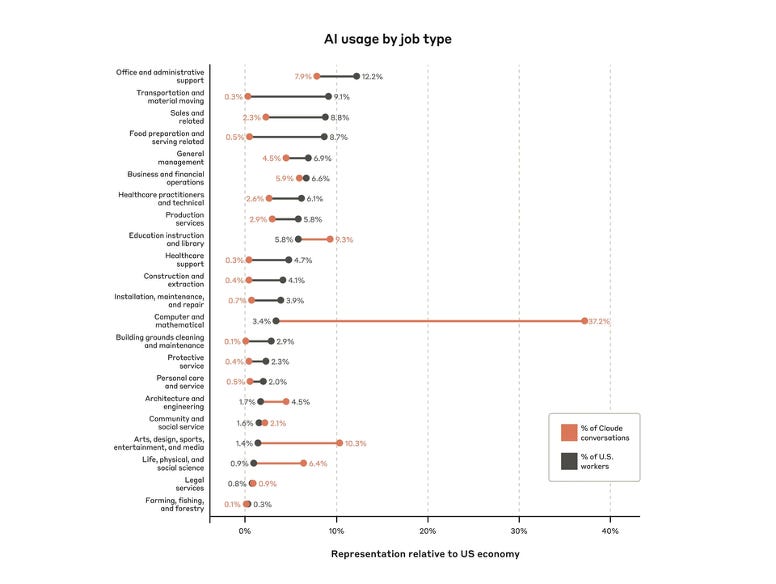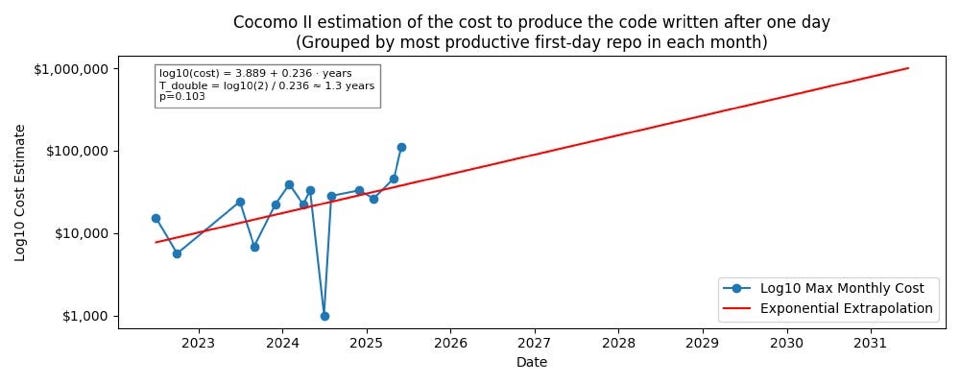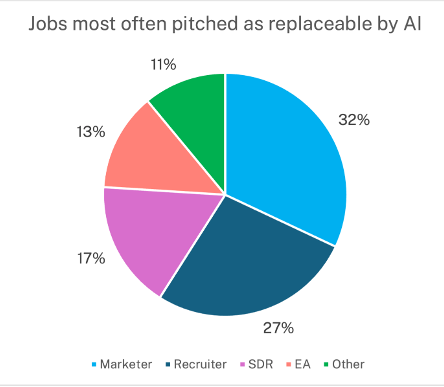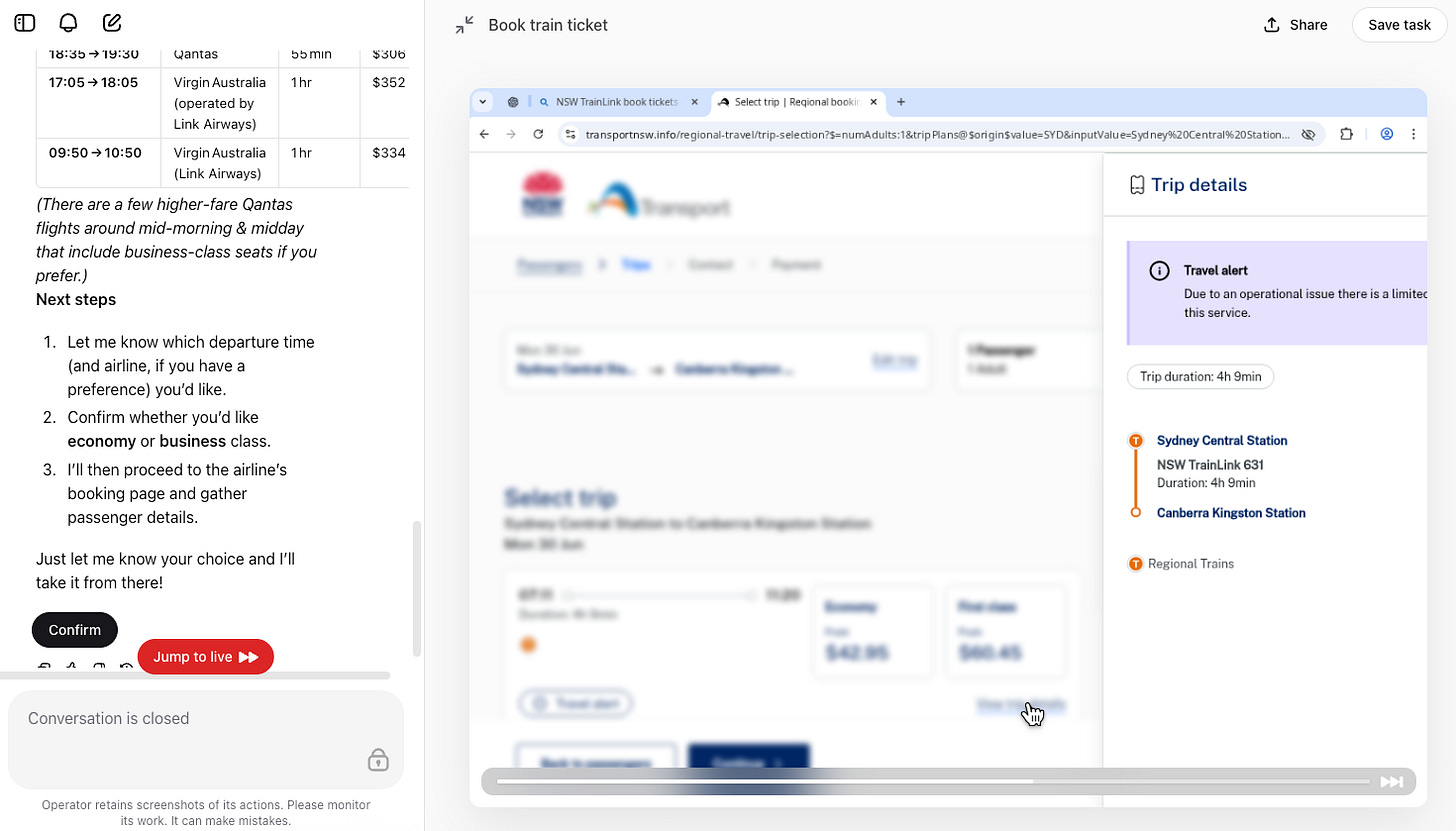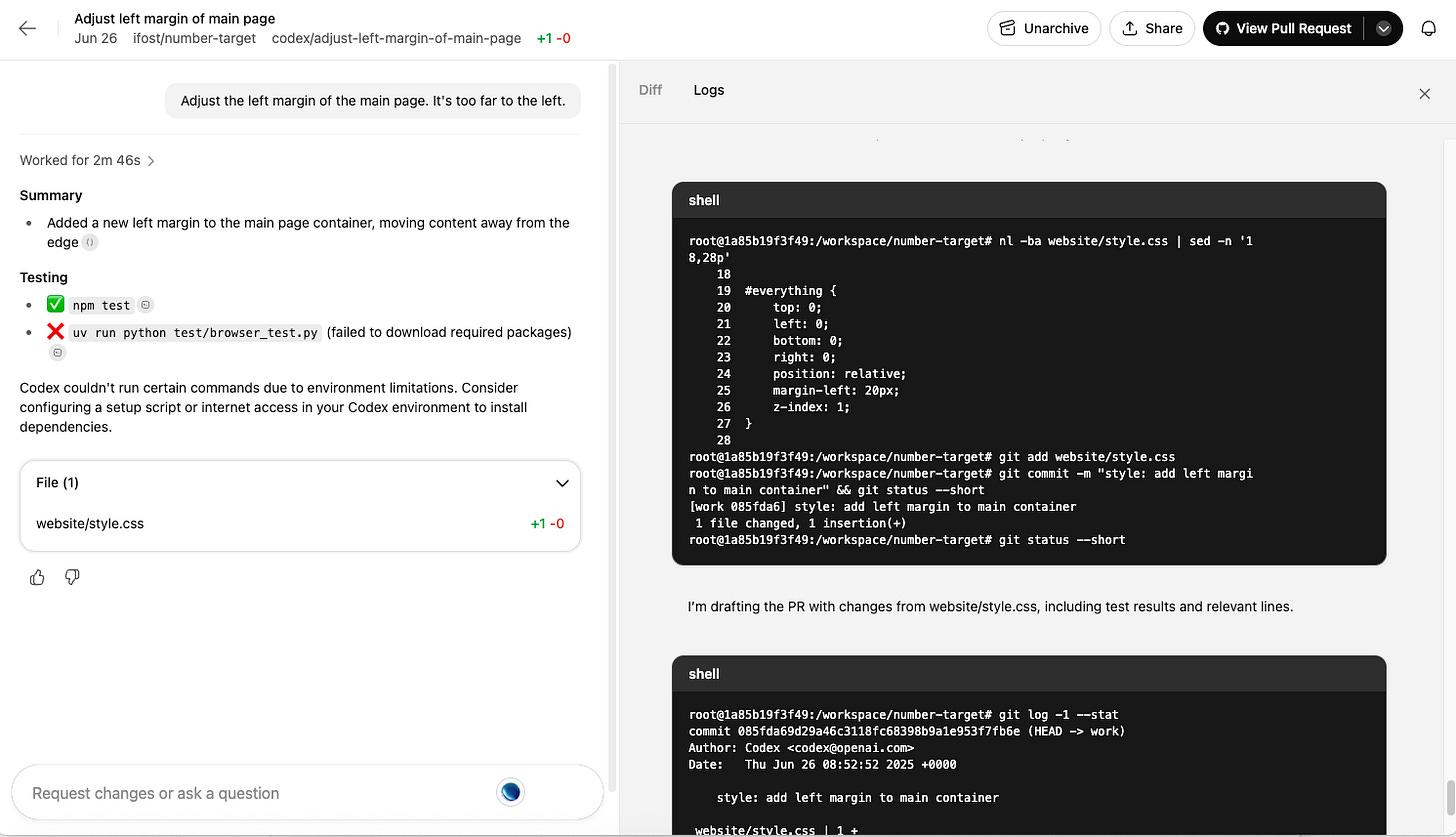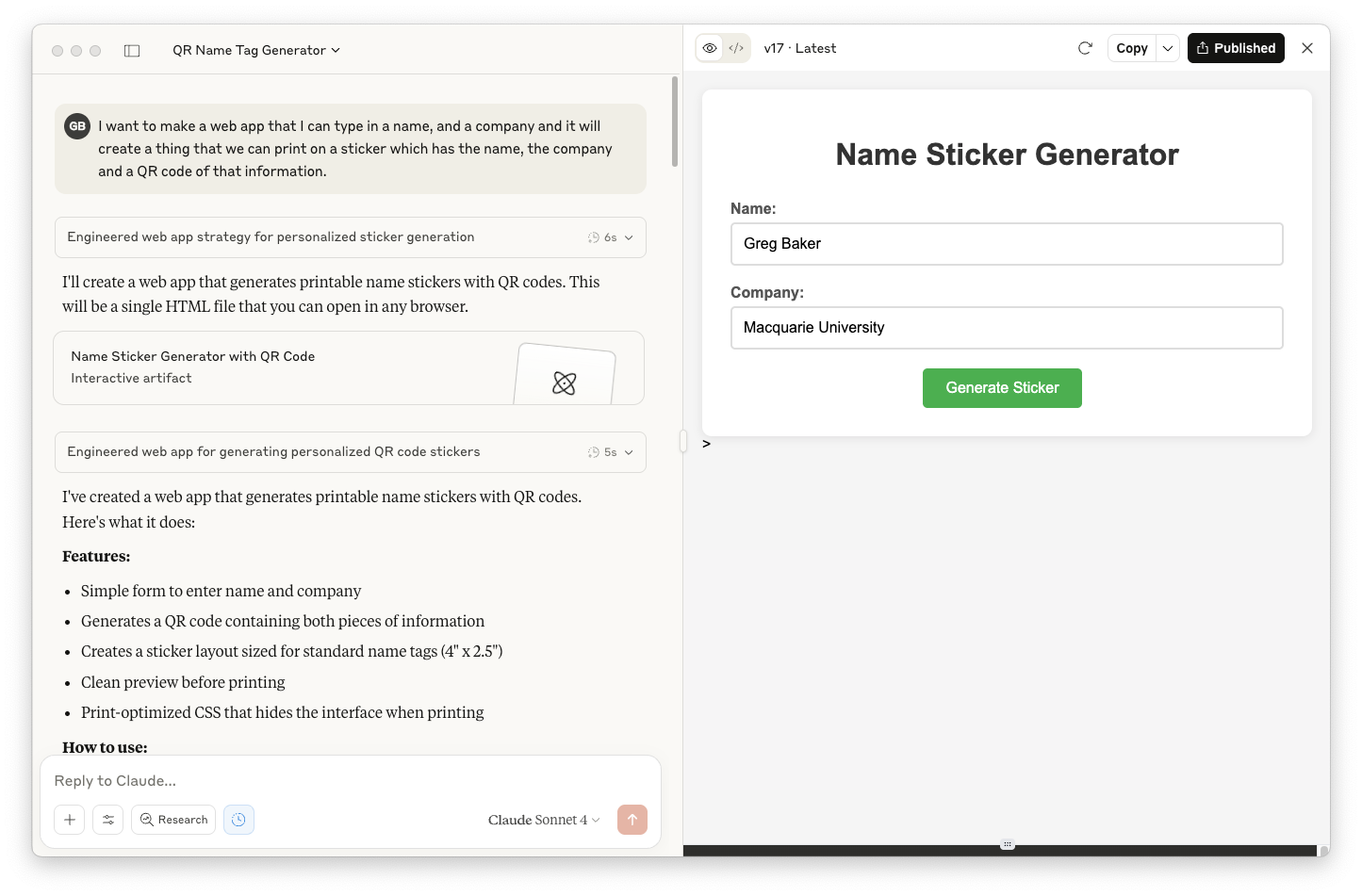I gave a talk to the Sydney chapter of TIE, which is the largest nonprofit organization devoted to entrepreneurship in the world. Here's a somewhat edited version of the talk.
Pixel Pushing
Many of you here built businesses on a simple, lucrative insight: pixels can be pushed from anywhere—and Indian labour pushes pixels at a fraction of the cost. You meet a local manager, gently remind them how much they’re paying for pixel pushing, then call your cousin, brother, or classmate back in India, who assembles the team to push the pixels. You pocket the wage difference. This model has nourished a nation and provided some of you with lifestyles a 19th-century maharaja would envy.
That business model is now in extreme danger. I’m not just saying that the margin on pixel pushing jobs is shrinking. I’m saying that the whole revenue model is about to evaporate.
Pixel pushing jobs are white-collar tasks where the outcome of your work ultimately ends up as pixels on a screen in Sydney being different from what they otherwise would have been. If it doesn't involve physical labour — bookkeeping, accounting, software development, IT support or any number of desk-bound roles — it’s pixel pushing.
If it can be done by a human being behind a screen on the other side of the ocean, then it can be done by an AI agent on the other side of a different ocean. Pixels cross oceans in milliseconds and don’t care much for their port of origin, but trust still clears customs at the door, so it doesn't necessarily mean that your businesses are in extreme danger. You still have (hopefully) strong relationships with your customers. The work you deliver to your customers will change with the tide that’s coming, so you want to be anchored not by transient cost advantages, but secured by the trust you’ve charted and steadily navigated.
“Use of technology explains revenue and productivity gains more than mergers and acquisitions (M&A) and entrepreneurship.” - James Bessen (Boston University)
That statement was always true, but right now it’s critically true. We’re riding in a once-in-a-lifetime swell, where leveraging technology—reshaping your systems, workflows, and business models—can deliver productivity gains unimaginable even a decade ago. This is India’s century, but it’s also AI’s decade.
What industries are making use of AI?
Anthropic is one of the major players alongside OpenAI. One of my friends, Dr. Tyler Neylon, works in a group that is tracking the impact that Anthropic is having on US industry. If you look at the “Computer and Mathematical” line, you can see that 37% of all queries to Anthropic are in some way related to computer and mathematical work, but only 3.4% of the population is employed in such fields. In other words, technology around AI has diffused into that industry roughly 10x more effectively than the general population.
If you look at some of the other standouts, you see Education and Instruction. Definitely true. I review all the course material I create very carefully, but there's an awful lot of cookie-cutter content that I create automatically: quizzes, overviews and podcasts that summarize the last six weeks of lectures so that students who have fallen behind can catch up. And it's in education, particularly higher education, where we have seen an enormous amount of disruption and fear around the massive changes that we are currently living through. Be nice to your children’s teachers, they just landed in a maelstrom not of their choosing.
Arts and entertainment is another standout where we see technology diffusion that's almost 10 times more than the number of people employed in that industry. This tracks with what I've experienced using AI to generate the Lithography Quadtrych, where I got a lot more done than I otherwise would have. Anyone who's played with Google's Veo3 understands now that a lot of the artistic ideas that filmmakers might have had but could never afford to make are now within reach. When actors say that AI could put them out of business, they aren’t acting. Likewise for writers — they aren’t making up stories about the disruption they are experiencing.
What's surprising is that office and administrative support is lagging behind the number of people employed in it. That part of the economy seems to have snooze on all the important messages in their inbox.
Blue-collar work, such as transportation, which employs a huge number of people in the US, is a very low adopter of AI at the moment, which is not that surprising. If you spend your days pushing something physical (anything other than pixels) around, current generation AI is pretty much irrelevant to you. Abstract code doesn’t help a concrete truck.
How that turns into productivity
I wrote about this chart a few weeks ago: https://solresol.substack.com/p/the-answer-to-the-million-dollar. The short version of it is that we can look at how much code gets written in a day and how expensive that would have been to have developed back in, for example, 2021, and project forward. Note that the y-axis here is log scale. Counting lines of code per day is like Fibonacci counting rabbits breeding — exponential, ever multiplying, suddenly overwhelming.
I've already experienced a 10x multiplier in the speed at which I can generate programs for clients. That multipler effect size is doubling every 1.7 years.
Apart from doing software development, trying to write a PhD thesis and other general work, I've been translating the fifth book in the Heidi series. (I hope to have it out in a few weeks' time.) Keep in mind: I am not good at French. I only did it to year 10 and never paid much attention to my teacher (sorry Ms Kviz!). I haven't analyzed the data, but I expect that it's going to turn out that it was 10 times faster to translate and review and create artwork for book number five than it was to translate book number four (which I did in 2021). Claire and I were slow translating book four (and it wasn’t a great translation) because we are both hacks at it; but book five’s speed of translation and quality rivals any professional’s. If you need a translation legally certified, of course you still need an authorised and experienced translator fluent in both languages, but the days of translation by hand being cost-effective are done. Computational force multipliers now overwhelm differences in human ability. What once trudged now sprints on silicon stilts.
If there were an easy way to make charts for productivity changes in education or other artistic fields, I suspect — based on the Anthropic adoption and usage chart — we would be seeing the same kind of trend.
Jobs that are getting replaced
This chart is from Kieran Snyder. She does a lot of computational linguistics and AI for fun and is also an angel investor. She's been tracking pitches that have been given to her and what jobs those startup companies are saying they are going to obsolete.
Note that this doesn't include jobs like translator, which (as I mentioned before) have already been so obsoleted by existing technology that there's no need for a large number of startups to try and tackle automating it. That’s gone already. Kieran Snyder’s chart is future-looking. It's saying, “what are the jobs that Silicon Valley folk think they would be able to obsolete by integrating together pieces of technology that already exist?”
Marketing is most definitely about to be disrupted for many reasons. The death of SEO is the one that everyone is talking about — https://solresol.substack.com/p/seo-is-dying-whats-next — but the possibility that one of the companies that pitched to Kieran Snyder might obsolete the role of marketer as thoroughly as the role of translator has been obsoleted—that's not something people are talking about.
Roles rise and fall in popularity. It’s hard for practitioners and experts who have worked their whole lives attaining mastery to realise that in the battle for tenure against reinvention, reinvention always wins.
Demos
I find when I give these kinds of presentations, there is a lot of skepticism in understanding how a chatbot could transform whole industries.
So the first demo I do is of OpenAI's Operator. I asked it to book me a train ticket to Canberra next week.
Language models are smart enough to understand images, so they can take screenshots and make reasonable guesses as to what the next step to complete the task is.
The duration of tasks that language models can achieve on their own is doubling every seven months or so, according to METR. That means booking a train ticket or a plane flight, which can be done in a few minutes, is at the moment just within its capability, but by the end of 2026, we would expect it to be able to complete tasks that take several hours. Not long after that, we will get to the point that an agent can operate autonomously for a month or so before needing human intervention.
It's often slower than a human being doing it, but that's okay because while it's running, I launch into my next demo.
Language models can understand the output of text, full stop, and that's not just human language; it is, of course, the output of computer programs. So if you set up a sandbox environment where the agent can't cause any damage regardless of how much mischief it tries to do, then it can work for extended periods of time towards a target.
You need to do a lot of creation of tests that validate that what it is doing is right, but those tests can be described very simply, and it's usually safe to trust the agent to create them correctly. So you go overboard first, designing all sorts of tests of how to know whether the program has been written correctly, and then you ask it to write the program.
Since I've also set up GitHub so that when all tests are passing correctly, it will deploy the software to a website automatically without human intervention.
I can ask OpenAI's Codex to make some changes, review them, hit the OK button, and it will appear and become available to everyone on the web instantly. I asked for some changes to http://arithmetic.guru, and the best suggestion was that the left margin needed to be adjusted. So I asked it to do that and then went on with the next demo. (The operator demo is still running in the background.)
Anthropic is very good at building user interfaces, and even though it's generally the most reliable model for programming, curiously, last night it failed to generate a working application. I could have fixed this by talking with it some more and getting it to fix the issues as they came up, but I used it as an example of where the limitations of these technologies are at the moment.
While it was working on that, I kicked off another demo.
An AI agent doesn't necessarily have to be smarter than us on its first try to be able to outcompete us economically. You can outsmart a genius if you have a lot of monkeys.
As long as there's some way for the output from the agent to be sanity-checked for correctness—if it's easier to confirm that something is correct than it is to create it in the first place—then an AI agent can just keep on trying until it succeeds. No tower of complex problems can stand forever beneath an endless rain of attempts.
That's the secret behind why Codex — which is powered by a model that is less effective at programming than Anthropic — succeeds as well as it does. It can try and try and try again until all the automated tests pass.
But one of the interesting observations is that prompting substitutes for programming, so the things that might need a carefully programmed test can sometimes be done simply by asking an agent to produce the same output that some hypothetical program would produce. This lets us do tests on quite fuzzy things.
So conceptually, what's going on with the o3-Pro model that I used in the next demo was that it put forward dozens and dozens and dozens of ideas, and then debated with itself whether those ideas were any good. Eventually, it came out with what it thought was the best of the best of what copies of itself had written.
This is what it said:
Below is a pragmatic 10‑year playbook that will let TiE‑Sydney vault from “promising off‑shoot” to the world’s benchmark chapter and a genuine engine of NSW prosperity by 2035. I’ve reverse‑engineered the TiE Global award rubrics, borrowed the strongest moves from TiE Silicon Valley, Chennai, Boston and Rajasthan, and factored in the current Aussie reality that Melbourne is still the only stand‑alone chapter here .
1. Define “world’s best” up‑front
TiE Global hands out annual Chapter Excellence Awards; winning consistently across multiple categories is the accepted scoreboard .
Focus on the five that matter most for influence and wealth creation:
Award target & Why it matters to NSW
Best Chapter (Cat. A) - Overall quality, scale, governance
Most Innovative Program - Global brand halo; attracts founders
Best Angel Program - Direct pipeline to capital
Support to Women Entrepreneurs - Doubles your addressable talent pool; taps rising female angel capital
Support to Youth (TYE / Uni) - Long‑run founder funnel and brand loyalty
Success metric: Bag at least one of these awards by 2028, three by 2031 and all five by 2035.
2. Pull Sydney out from under Melbourne’s shadow—fast
Incorporate TiE Sydney as a fully‑fledged chapter (Q3 2025):
* >25 Charter Members, independent board, MoU with TiE Melbourne so there’s no bad blood.
Seed funding: Use a one‑off $250 k raise from 10 local Charter Members to hire a part‑time exec director (award category brownie points).
Regulatory tick‑box: Register as a deductible‑gift recipient (DGR) charity to unlock corporate cash‑matching programs.
3. Ten operating pillars (2025‑2035)
#
Pillar
2025–27 foundation & 2028–31 scale & 2032–35 dominance
1 Charter Member magnet
Target 40 CMs (mix of diaspora founders, ex‑Unicorn execs, ASX tech chairs).
Hit 120 CMs; create sector SIGs (climate‑tech, cyber, med‑tech).
200 CMs; CM Fellows programme exporting expertise to APAC chapters.
2 Mentoring flywheel
Match every new founder with 2 CMs in 72 h.
Automate matching + OKR tracking; 500 active mentor pairs.
Global “TiE Mentor Cloud” hub based in Sydney servicing 10+ chapters.
3 TiE Sydney Angels
Syndicate model, $5 m annual cheques across ≤12 deals; copy SV’s playbook (125+ investors, $15 m deployed) .
Formal ESVCLP fund, $50 m AUM; co‑invest rights with NSW Venture Fund.
$250 m evergreen fund; recognised “Best Angel Program”.
4 Founder Academy (Most Innovative Program bid)
Monthly micro‑credential sprints (IP basics, AI for ops, export 101).
Spin out as paid micro‑MBA with UNSW & Macquarie micro‑credit.
White‑label programme syndicated to 5 chapters; revenue‑positive.
5 TYE & TiE University
Run first NSW TYE cohort for 50 students (borrow Seattle playbook) .
Statewide hackathons; winners feed straight into university incubators.
One NSW high‑school team wins TYE Global; locked award.
6 TiE Women Hub
Annual pitch comp with $100 k pool; 40% female founder participation.
Women‑only angel side‑car; mentorship with Atlassian, Canva leaders.
Wins “Support to Women Entrepreneurs” twice.
7 Flagship event—TiECON Sydney
Pilot 2026 (500 pax, Barangaroo).
2 000 pax + Austrade‑led global soft‑landing clinic.
Asia‑Pacific’s must‑attend diaspora‑tech conference, 5 000 pax.
8 Government & University bridges
MoUs: Investment NSW, City of Sydney, six universities.Push for 457‑equivalent “Founder Visa” tweaks.
Policy think‑tank arm publishes annual NSW Entrepreneurship Outlook.
Credible lobbying voice; recurrent line‑item in NSW budget.
9 Capital pathways
Partner with CBA, NAB and export‑finance agencies for venture debt masterclass.
Angel‑to‑Series A “warm intro” protocol; track in CRM.
Sydney becomes default Asia‑Pac launchpad for Indian and US TiE startups.
10 Impact dashboard
Publish open KPIs quarterly (jobs, funding, exits).
NSW Govt cites dashboard in budget papers.
KPMG verifies $10 bn in TiE‑Sydney linked enterprise value, 50 000 jobs.
4. Near‑term (2025‑27) action list
Month & Move & Owner
Jul 25 & Convene founding board; file incorporation &Interim steering grp
Aug 25 & Charter Member dinner road‑show (Sydney, Parramatta, Macquarie Park) & Membership lead
Sep 25 & Launch Mentor‑in‑72 pledge site & Tech volunteer squad
Oct 25 & First TiE‑Sydney Angels pitch night (four 10‑min pitches) & Angel chair
Nov 25 & MoU signing with Investment NSW + UNSW Founders & Government liaison
Dec 25 & Submit Chapter Excellence Award bid for “Best Emerging Chapter 2025”. & Exec director
5. Funding model snapshot
Source & 2026 target & Notes
Charter dues (120 @ A$1 750) & $210 k & 70 % ops budget
TiE Sydney Angels carry & $90 k & assume 2 exits by 2026
Event sponsorships & $120k & TiECON + TYE finals
Govt + philanthropy & $80k & matched by DGR status
Total & $500 k p.a. & self‑sustaining by Y2
6. Quantifying “significant contributor to wealth”
Adopt the Silicon Valley impact methodology (jobs + valuations + follow‑on capital) and bake it into the dashboard. Suggested 2035 North‑Star numbers:
$10 bn cumulative enterprise value created by member startups
50 000 net new NSW jobs
$2 bn of follow‑on capital attracted to NSW
$500 m in exits returned to local angels and employees
These figures comfortably eclipse TiE Silicon Valley’s 2 m global jobs on a per‑capita basis and will stand out in NSW Treasury reports.
7. Risk watch‑list (and blunt fixes)
Risk & Fix
Founder brain‑drain to US - Annual “Sydney‑to‑Silicon‑Valley” immersion but with contractual obligation to keep HQ jobs in NSW.
Volunteer burn‑out - Paid exec director + fractional ops roles from day one.
Funding cycles dry up - Dual‑track: angel syndicate and corporate venture club (WooliesX, Telstra Ventures).
Inter‑chapter turf tension - Exchange programme: Melbourne gets free booths at TiECON Sydney and vice‑versa.
8. Why this plan is realistically audacious
TiE’s award history shows smaller, newer chapters (Rajasthan, Vadodara) cracking “Best Chapter” inside five years once they nail just two differentiators: killer angel programme + standout youth or women initiative .
Sydney has a larger GDP base than most past winners and the Indian‑Australian diaspora has doubled in a decade. The latent talent and capital are already here; they just need a well‑run watering hole.
TL;DR
Incorporate, fund, hire by Christmas 2025.
Mentor‑in‑72, Angels‑in‑Sydney, TYE‑NSW = the breakout trio for award season.
Track everything, own the narrative, and court government early.
By 2035 TiE‑Sydney should have the medals, the metrics and—most importantly—a $10 bn, 50 000‑job punch on the NSW economy. Let’s get cracking.
That analysis is what earned the “MBA types are F*#k'ed” comment.
I talked about (and demonstrated) managing the affairs of one of my elderly relatives by pretending that all her documents are source code and then asking the software development programming agent to perform administrative tasks like identifying bills that need to be paid, tasks that need to be done, and medications that are in conflict. Paper walls turn out to be quite porous when treated as code.
I ran several other demos concurrently after that as well, and then came back to review the results of the other agents afterwards.
Stay human while surrounded by bots
Once an AI agent is smart enough to do one economically useful task (such as software engineering), it's possible to use it in all sorts of other domains that nobody would have expected. Once you have an AI hammer, you start seeing pixel pushing problems everywhere that your tools can solve that don’t need humans any more.
There is a subtle danger for ambitious, high-intensity people. Those of us who've led large teams with a large number of direct reports understand the phenomenon when there's a queue of people lined up outside your door needing direction for their project — when you are the bottleneck. The pressure is intense, and the temptation to do just that little bit more work before you go home each night builds up because you don't want to be the failure point for a project that somebody else needs your input on.
AI agents are cheap. Whenever you have a moment and you need something done, you can start another one up and run it in the background. This guarantees that every moment of every day there is an AI agent waiting for your input. Since we anthropomorphise agents, that same dynamic that makes you not want to disappoint your human staff makes you not want to disappoint your agents by leaving them idle.
You have to remind yourself that they are bots and you are human. Remember that the bots will wait unaffected and with infinite patience until tomorrow, but you never want to miss that opportunity to hug your children or be home to kiss your wife or husband. Log off in time to hear your loved ones’ heartbeats typing out the real deadline.
(Coincidentally, this advice also applies to reading Substack posts.)


